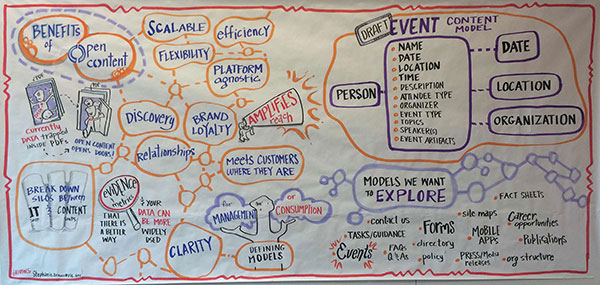Top 5 Reasons to Use Government-wide Open and Structured Content Models
Content models provide an opportunity for agencies to structure, organize, distribute, and better publish information in multiple forms and on multiple platforms. Federal agencies discussed why content models are important for future-facing content in our What Structured Content Models Can Do For You Webinars in May and June.

The point—with good content models, a single piece of Web content becomes an adaptive information asset that can be leveraged anytime, anywhere.
Holly Irving, from the National Institutes of Health, leads a government-wide working group which has been researching industry metadata standards to find common elements for all agencies to use. In May, the group, sponsored by the Digital Services Innovation Center, released government-wide content models.
Irving recently gave us five reasons why agencies should start using the government shared Article and Event models, released in May, and stop reinventing the content wheel:
- Commonality = Interoperability: When agencies all use the same models, their Web content can be freely exchanged within and outside the federal government, providing more efficient use of communications resources and a high quality, uniform message for constituents. When created using a common structure, your content is more easily found, gathered, organized and distributed, regardless of platform, format or device.
- Flexibility: Content is no longer a single unit written for a single purpose. With content models, it becomes a logical aggregation of smaller pieces or “chunks” each defined as a metadata element. The working group models include metadata elements that give APIs and search engines a description of your content, the title, topic keywords and the source organization, for example.
- Easy Adoption: The models are simple, defining a core set of metadata elements; just a few required elements and a few common optional metadata. Many of these elements may already be used by your agency’s CMS. This streamlined approach promotes government-wide adoption and seamless access to a plethora of easily customizable, organized information. A simpler way of sharing what you publish most is at your fingertips—grab it!
- Content Models Cover the Most Common Types of Government Web Content: The Article and Event models, are geared to provide a template for structuring digital information that makes Create Once, Publish Everywhere (COPE) possible. The Article and Events models are not intended to be exhaustive. They serve as a common starting point. When agencies identify elements that are not covered by these two content models they can extend them with additional elements.
- Aligned with the Digital Government Strategy Pillars: Digital Government Strategy objectives highlight an information-centric and customer-centric approach to creating and providing digital information. By adopting common content models, digital information from across all government agencies in all media types can be easily located, compiled, and analyzed. News articles, illustrations, research results, and more can be aggregated to provide customers what they need, where they need it, and when they need it.
Interested in learning how to take the first step in improving your agency’s accessibility and usability with the Open and Structured Content Models?
You can comment and improve on the content models anytime on GitHub. Also, sign up for the Open and Structured Content Models Project Hands On Workshop on September 16.
Holly Irving is a Digital Information Specialist for the National Institute of Allergy and Infectious Diseases at the National Institutes of Health.

